
Pine barrens, pine plains, sand plains, or pinelands occur throughout the U.S. from Florida to Maine as well as the Midwest, West, and Canada and parts of Eurasia. Pine barrens are plant communities that occur on dry, acidic, infertile soils, dominated by grasses, forbs, low shrubs, and small to medium-sized pines. The most extensive barrens occur in large areas of sandy glacial deposits, lakebeds, and outwash terraces along rivers.
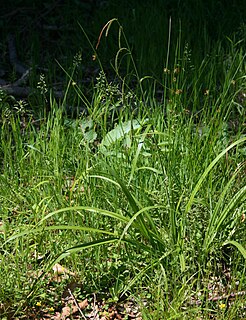
Carex pendula is a large sedge of the genus Carex. It occurs in woodland, scrubland, hedges and beside streams, preferring damp, heavy clay soils. It is sometimes grown as a garden plant because of its distinctive appearance.

Carex rossii, commonly known as Ross's sedge, is a hardy species of sedge that is often a pioneer species in areas with little or no established vegetation, or in places where disturbance has occurred. Ross's sedge grows in a variety of habitats throughout much of western North America, from Alaska to Ontario, south to New Mexico and California. It flowers in May and June.

Carex vesicaria is an essentially Holarctic species of sedge known as bladder sedge, inflated sedge, and blister sedge. It has been used to insulate footwear in Norway and among the Sami people, and for basketry in North America.

Carex binervis, the green-ribbed sedge, is a European species of sedge with an Atlantic distribution. It is found from Fennoscandia to the Iberian Peninsula, and occurs in heaths, moorland and other damp, acidic environments. It typically grows to a height of 15–120 cm (6–50 in), and has inflorescences comprising one male and several female spikes, each up to 45 mm (1.8 in) long. The utricles have two conspicuous green veins, which give rise to both the scientific name and the common name of the species. In the vegetative state, it closely resembles C. bigelowii, a species that usually grows at higher altitude. C. binervis was first described by James Edward Smith in 1800, and is classified in Carex sect. Spirostachyae; several hybrids with other Carex species are known.

Rhynchospora knieskernii is a rare species of sedge known by the common name Knieskern's beaksedge. It is endemic to the state of New Jersey in the United States, where it occurs naturallyin the Pine Barrens. Reports have cited it present in Delaware as well, but these populations appear to have been introduced. It is threatened by the destruction and degradation of its habitat. It is a federally listed threatened species of the United States.

Scirpus ancistrochaetus is a rare species of flowering plant in the sedge family known by the common names barbedbristle bulrush and northeastern bulrush. It is native to the northeastern United States from New Hampshire south to Virginia. It used to be found in Quebec but it is now thought to be extirpated there. It was also believed extirpated from the state of New York, but at least one population has been rediscovered in Steuben County in 2010. It is threatened by the loss and degradation of its wetland habitat. It is a federally listed endangered species.

Carex bigelowii is a species of sedge known by the common names Bigelow's sedge, Gwanmo sedge, and stiff sedge. It has an Arctic–alpine distribution in Eurasia and North America, and grows up to 50 centimetres (20 in) tall in a variety of habitats.
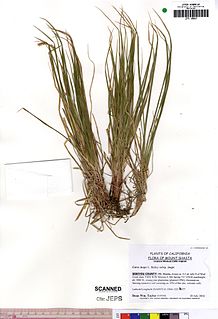
Carex inops is a species of sedge known as long-stolon sedge and western oak sedge. It is native to northern North America, where it occurs throughout the southern half of Canada and the western and central United States.

Carex livida is a species of sedge known by the common names livid sedge and pale sedge.

Carex saxatilis is a species of sedge known by the common names rock sedge and russet sedge.
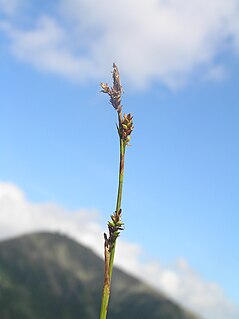
Carex vaginata is a species of sedge known by the common name sheathed sedge. It has a circumboreal distribution, occurring throughout the northern latitudes of the Northern Hemisphere. It occurs in Alaska, throughout most all of Canada to Greenland and in Eurasia. In North America it occurs as far south as Minnesota and New York.
Carex oronensis is a species of sedge known by the common name Orono sedge. It is endemic to Maine in the United States, where it occurs mainly in the Penobscot River Valley. It is the only plant that is endemic to the state of Maine. The type locality is Orono.
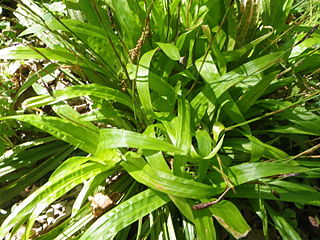
Carex plantaginea, commonly known as carex plantain, plaintainleaf sedge, or seersucker sedge, is a perennial herb of the sedge family.

Carex distans, commonly known as distant sedge, is a plant species in the sedge family, Cyperaceae. It is native to Europe and North Africa. It is part of a complex of similar species that occur across Eurasia. Its relatives include Carex diluta of central Asia, which has also introduced to North America in Montana. Carex distans has been introduced to the US states including Maryland and Pennsylvania. More recently, it was found in Oregon. There is a report from Victoria, Australia as well.
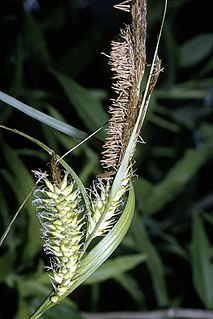
Carex lacustris, known as lake sedge, is a tufted grass-like perennial of the sedge family (Cyperaceae), native to southern Canada and the northern United States. C. lacustris us an herbaceous surface-piercing plant that grows in water up to 50 cm (1.6 ft) deep, and grows 50–150 cm (1.6–4.9 ft) tall. It grows well in marshes and swampy woods of the boreal forest, along river and lake shores, in ditches, marshes, swamps, and other wetland habitat. It grows on muck, sedge peat, wet sand or silt, in filtered or full sunlight.
Carex bulbostylis, known as the false hair sedge, is a species of sedge native to the southcentral and southeastern United States. It was first formally named by Kenneth Mackenzie in 1915. It is also known as the eastern narrowleaf sedge, thick style sedge, and globose sedge.

Carex juniperorum, the juniper sedge, is a perennial flowering plant native to North America, first described by botanist William J. Crins in 1993. C. juniperorum is in the Cyperaceae (sedge) family, and is closely related to C. jamesii and C. willdenowii. It is commonly called juniper sedge as it is often seen growing in areas with red cedar, though the presence of cedar is not necessarily a requirement for it to grow.

Grīņu Nature Reserve — nature reserve, located in Saka Parish, South Kurzeme Municipality in the Courland region of Latvia. Founded in 1936, it belongs to the European Conservation Network Natura 2000. 1,505 hectares of natural habitat are under protection. The Grīņu Reserve is subordinated to the Regional Council for Nature Conservation Courland.

















